Optimized Ammonia-Sensing Electrode with CeO2/rGO Nano-Composite Coating Synthesized by Focused Laser Ablation in Liquid
Abstract
1. Introduction
2. Experimental Methods
3. Results and Discussion
4. Conclusions
Supplementary Materials
Author Contributions
Funding
Data Availability Statement
Acknowledgments
Conflicts of Interest
References
- Wyer, K.E.; Kelleghan, D.B.; Blanes-Vidal, V.; Schauberger, G.; Curran, T.P. Ammonia emissions from agriculture and their contribution to fine particulate matter: A review of implications for human health. J. Environ. Manag. 2022, 323, 116285. [Google Scholar] [CrossRef]
- Brannelly, N.T.; Hamilton-Shield, J.P.; Killard, A.J. The Measurement of Ammonia in Human Breath and its Potential in Clinical Diagnostics Crit. Rev. Anal. Chem. 2016, 46, 490. [Google Scholar] [CrossRef] [PubMed]
- Ott, P.; Vilstrup, H. Cerebral effects of ammonia in liver disease: Current hypotheses. Metab. Brain Dis. 2014, 29, 901–911. [Google Scholar] [CrossRef]
- Moore, J.H.; Boczko, E.M.; Summar, M.L. Connecting the dots between genes, biochemistry, and disease susceptibility: Systems biology modeling in human genetics. Mol. Genet. Metab. 2005, 84, 104–111. [Google Scholar] [CrossRef]
- Holecek, M. Ammonia and amino acid profiles in liver cirrhosis: Effects of variables leading to hepatic encephalopathy. Nutrition 2015, 31, 14. [Google Scholar] [CrossRef] [PubMed]
- Butterworth, R.F. Pathophysiology of Hepatic Encephalopathy: A New Look at Ammonia. Metab. Brain Dis. 2002, 17, 221–227. [Google Scholar] [CrossRef]
- Watanabe, A. Cerebral changes in hepatic encephalopathy. J. Gastroenterol. Hepatol. 1998, 13, 752–760. [Google Scholar] [CrossRef]
- Zieve, L. Pathogenesis of hepatic encephalopathy. Metab. Brain Dis. 1987, 2, 147. [Google Scholar] [CrossRef] [PubMed]
- Mazelis, M. 15—Amino Acid Catabolism. Amino Acid Catabolism; Miflin, B.J., Ed.; Academic Press: Cambridge, MA, USA, 1980; p. 541. [Google Scholar]
- Duan, Y.; Liu, Q.; Wang, Y.; Zhang, J.; Xiong, D. Impairment of the intestine barrier function in Litopenaeus vannamei exposed to ammonia and nitrite stress. Fish Shellfish Immunol. 2018, 78, 279–288. [Google Scholar] [CrossRef]
- Wu, Y.; Xia, Y.; Hu, A.; Xiong, G.; Wu, W.; Shi, L.; Chen, L.; Guo, X.; Qiao, Y.; Liu, C.; et al. Difference in muscle metabolism caused by metabolism disorder of rainbow trout liver exposed to ammonia stress. Sci. Total. Environ. 2024, 924, 171576. [Google Scholar] [CrossRef]
- He, K.; Luo, X.; Wen, M.; Wang, C.; Qin, C.; Shao, J.; Gan, L.; Dong, R.; Jiang, H. Effect of acute ammonia toxicity on inflammation, oxidative stress and apoptosis in head kidney macrophage of Pelteobagrus fulvidraco and the alleviation of curcumin. Comp. Biochem. Physiol. Part C Toxicol. Pharmacol. 2021, 248, 109098. [Google Scholar] [CrossRef] [PubMed]
- Deepak, K.; Balapure, A.; Priya, P.; Kumar, P.; Dubey, S.K.; Javed, A.; Chattopadhyay, S.; Goel, S. Development of a microfluidic device for the dual detection and quantification of ammonia and urea from the blood serum. Sens. Actuators A Phys. 2024, 369, 115174. [Google Scholar] [CrossRef]
- Shooshtari, M.; Salehi, A. An electronic nose based on carbon nanotube -titanium dioxide hybrid nanostructures for detection and discrimination of volatile organic compounds. Sens. Actuators B Chem. 2022, 357, 131418. [Google Scholar] [CrossRef]
- Privett, B.J.; Shin, J.H.; Schoenfisch, M.H. Electrochemical Sensors. Anal. Chem. 2010, 82, 4723. [Google Scholar] [CrossRef] [PubMed]
- Saputra, H.A. Electrochemical sensors: Basic principles, engineering, and state of the art. Monatsh. Chem. 2023, 154, 1083–1100. [Google Scholar] [CrossRef]
- Bakker, E.; Telting-Diaz, M. Electrochemical Sensors. Anal. Chem. 2002, 74, 2781. [Google Scholar] [CrossRef] [PubMed]
- Gorbova, E.; Tzorbatzoglou, F.; Molochas, C.; Chloros, D.; Demin, A.; Tsiakaras, P. Fundamentals and Principles of Solid-State Electrochemical Sensors for High Temperature Gas Detection. Catalysts 2022, 12, 1. [Google Scholar] [CrossRef]
- Zaidi, S.A.; Shin, J.H. Molecularly Imprinted Polymer Electrochemical Sensors Based on Synergistic Effect of Composites Synthesized from Graphene and Other Nanosystems. Int. J. Electrochem. Sci. 2014, 9, 4598–4616. [Google Scholar] [CrossRef]
- Lin, B.; Liu, Y.; Heng, L.; Wang, X.; Ni, J.; Lin, J.; Jiang, L. Morphology Effect of Ceria on the Catalytic Performances of Ru/CeO2 Catalysts for Ammonia Synthesis. Ind. Eng. Chem. Res. 2018, 57, 9127–9135. [Google Scholar] [CrossRef]
- Ly, T.N.; Park, S. Highly sensitive ammonia sensor for diagnostic purpose using reduced graphene oxide and conductive polymer. Sci. Rep. 2018, 8, 18030. [Google Scholar] [CrossRef]
- Huang, T.-Y.; Kung, C.-W.; Wei, H.-Y.; Boopathi, K.M.; Chu, C.-W.; Ho, K.-C. A high performance electrochemical sensor for acetaminophen based on a rGO–PEDOT nanotube composite modified electrode. J. Mater. Chem. A 2014, 2, 7229–7237. [Google Scholar] [CrossRef]
- Wang, C.; Zhang, L.; Guo, Z.; Xu, J.; Wang, H.; Zhai, K.; Zhuo, X. A novel hydrazine electrochemical sensor based on the high specific surface area graphene. Microchim. Acta 2010, 169, 1–6. [Google Scholar] [CrossRef]
- Li, Y.; Zhang, P.; Ouyang, Z.; Zhang, M.; Lin, Z.; Li, J.; Su, Z.; Wei, G. Nanoscale Graphene Doped with Highly Dispersed Silver Nanoparticles: Quick Synthesis, Facile Fabrication of 3D Membrane-Modified Electrode, and Super Performance for Electrochemical Sensing. Adv. Funct. Mater. 2016, 26, 2122–2134. [Google Scholar] [CrossRef]
- Yang, G.W. Laser ablation in liquids: Applications in the synthesis of nanocrystals. Mater. Sci. 2007, 52, 648. [Google Scholar]
- Shi, M.; Kitamoto, Y.; Hara, M.; Wada, H. Preparation of CeO2 nanoparticles by laser ablation in liquid method and its UV-absorption properties. Appl. Phys. A 2022, 128, 968. [Google Scholar] [CrossRef]
- Monsa, Y.; Gal, G.; Lerner, N.; Bar, I. A simple strategy for enhanced production of nanoparticles by laser ablation in liquids. Nanotechnology 2020, 31, 235601. [Google Scholar] [CrossRef]
- Tilaki, R.M.; Zad, A.I.; Mahdavi, S.M. The effect of liquid environment on size and aggregation of gold nanoparticles prepared by pulsed laser ablation. J. Nanopart. Res. 2007, 9, 853–860. [Google Scholar] [CrossRef]
- Elsayed, K.A.; Imam, H.; Ahmed, M.; Ramadan, R. Effect of focusing conditions and laser parameters on the fabrication of gold nanoparticles via laser ablation in liquid. Opt. Laser Technol. 2013, 45, 495–502. [Google Scholar] [CrossRef]
- Dittrich, S.; Spellauge, M.; Barcikowski, S.; Huber, H.P.; Gökce, B. Time resolved studies reveal the origin of the unparalleled high efficiency of one nanosecond laser ablation in liquids. Opto-Electron. Adv. 2022, 5, 210053. [Google Scholar] [CrossRef]
- Devaux, D.; Fabbro, R.; Tollier, L.; Bartnicki, E. Generation of shock waves by laser-induced plasma in confined geometry. J. Appl. Phys. 1993, 74, 2268–2273. [Google Scholar] [CrossRef]
- Berthe, L.; Fabbro, R.; Peyre, P.; Bartnicki, E. Wavelength dependent of laser shock-wave generation in the water-confinement regime. J. Appl. Phys. 1999, 85, 7552–7555. [Google Scholar] [CrossRef]
- Waag, F.; Gökce, B.; Barcikowski, S. Ablation target cooling by maximizing the nanoparticle productivity in laser synthesis of colloids. Appl. Surf. Sci. 2019, 466, 647–656. [Google Scholar] [CrossRef]
- Taccogna, F. Nucleation and growth of nanoparticles in a plasma by laser ablation in liquid. J. Plasma Phys. 2015, 81, 495810509. [Google Scholar] [CrossRef]
- Luo, F.; Guan, Y.; Ong, W.; Du, Z.; Ho, G.; Li, F.; Sun, S.; Lim, G.; Hong, M. Enhancement of pulsed laser ablation in environmentally friendly liquid. Opt. Express 2014, 22, 23875–23882. [Google Scholar] [CrossRef]
- Nayral, C.; Viala, E.; Fau, P.; Senocq, F.; Jumas, J.-C.; Maisonnat, A.; Chaudret, B. Synthesis of Tin and Tin Oxide Nanoparticles of Low Size Dispersity for Application in Gas Sensing. Chem. A Eur. J. 2000, 6, 4082–4090. [Google Scholar] [CrossRef]
- Sajti, C.L.; Sattari, R.; Chichkov, B.N.; Barcikowski, S. Gram Scale Synthesis of Pure Ceramic Nanoparticles by Laser Ablation in Liquid. J. Phys. Chem. C 2010, 114, 2421–2427. [Google Scholar] [CrossRef]
- Shi, M.; Kitamoto, Y.; Wada, H. Synthesis of CeO2/rGO Nanocomposites by Laser Ablation in Liquid Method and the Characterization for Advanced Materials Development. J. Laser Micro Nanoeng. 2023, 18, 170–176. [Google Scholar]
- Soliman, W.; El-Ansary, S.; Badr, Y. Impact of Liquid Medium on Laser Ablation Mechanism: Surface Heating and Cooling. Lasers Manuf. Mater. Process. 2018, 5, 430–438. [Google Scholar] [CrossRef]
- Tabayashi, Y.; Sakaki, S.; Koshizaki, N.; Yamauchi, Y.; Ishikawa, Y. Behavior of Thermally Induced Nanobubbles during Instantaneous Particle Heating by Pulsed Laser Melting in Liquid. Langmuir 2021, 37, 7167–7175. [Google Scholar] [CrossRef]
- Zolotko, A.N.; Poletaev, N.I.; Vovchuk, J.I.; Florko, A.V. Nanoparticles formation by combustion techniques. In Gas Phase Nanoparticle Synthesis, Chapter 5; Granqvist, C.G., Kish, L.B., Marlow, W.H., Eds.; Kluwer Academic: Dordrecht, The Netherlands, 2004; pp. 123–156. [Google Scholar]
- Koehler, J.M.; Visaveliya, N.; Knauer, A. Controlling formation and assembling of nanoparticles by control of electrical charging, polarization, and electrochemical potential. Nanotechnol. Rev. 2014, 3, 553–568. [Google Scholar] [CrossRef]
- Bourrous, S.; Ribeyre, Q.; Lintis, L.; Yon, J.; Bau, S.; Thomas, D.; Vallières, C.; Ouf, F.-X. A semi-automatic analysis tool for the determination of primary particle size, overlap coefficient and specific surface area of nanoparticles aggregates. J. Aerosol Sci. 2018, 126, 122–132. [Google Scholar] [CrossRef]
- Kocsis, L.; Herman, P.; Eke, A. The modified Beer–Lambert law revisited. Phys. Med. Biol. 2006, 51, N91. [Google Scholar] [CrossRef] [PubMed]
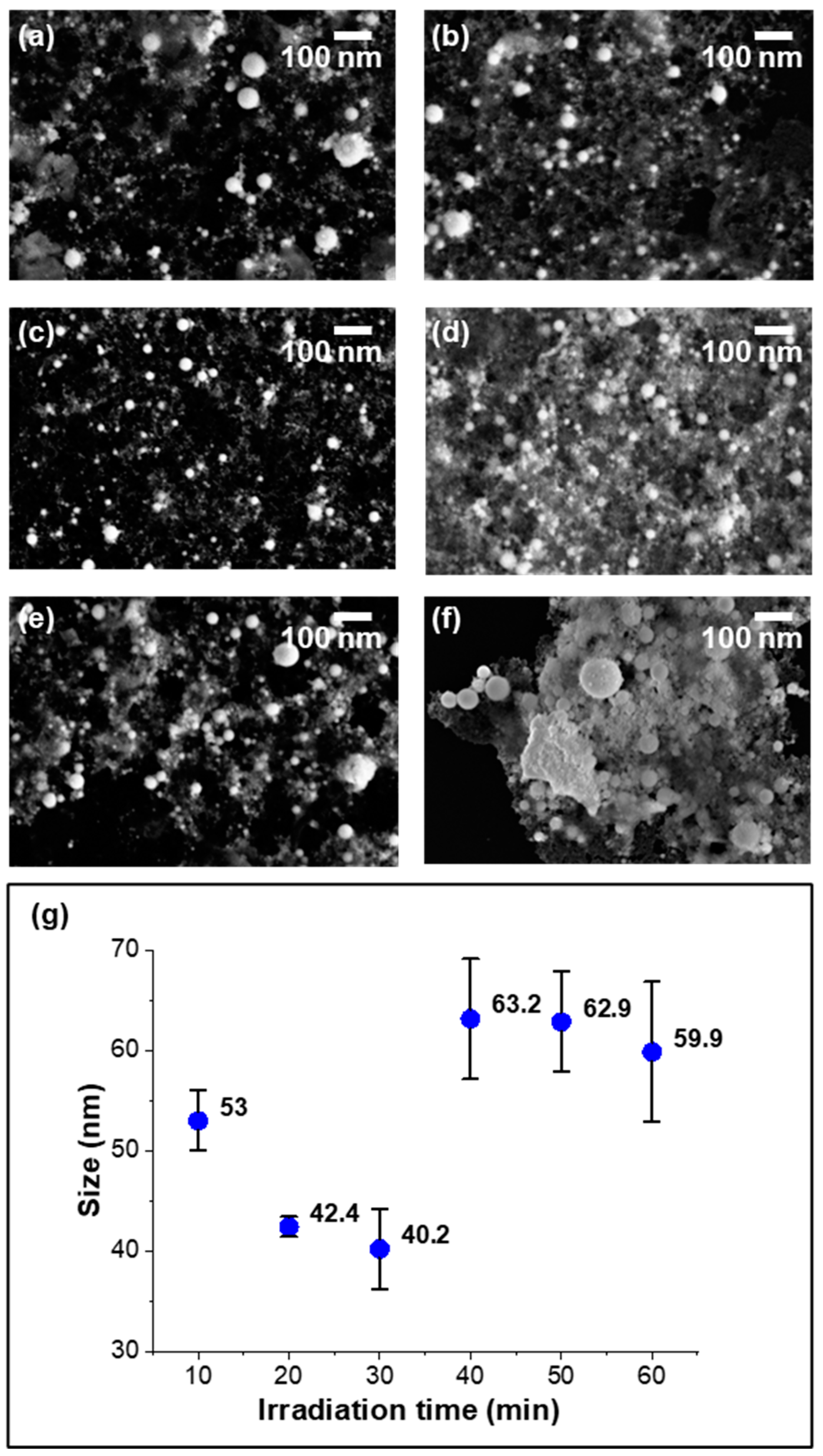
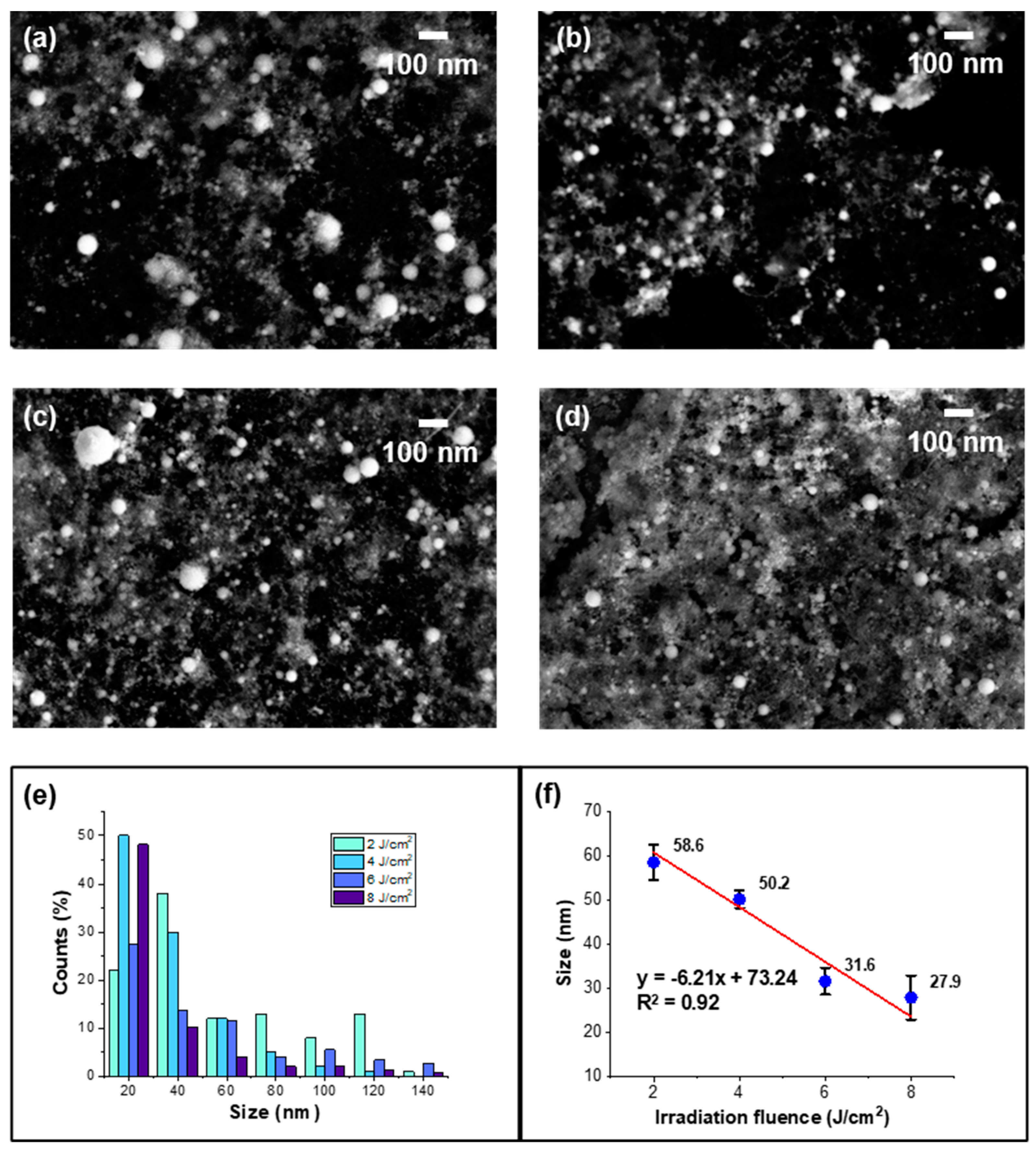
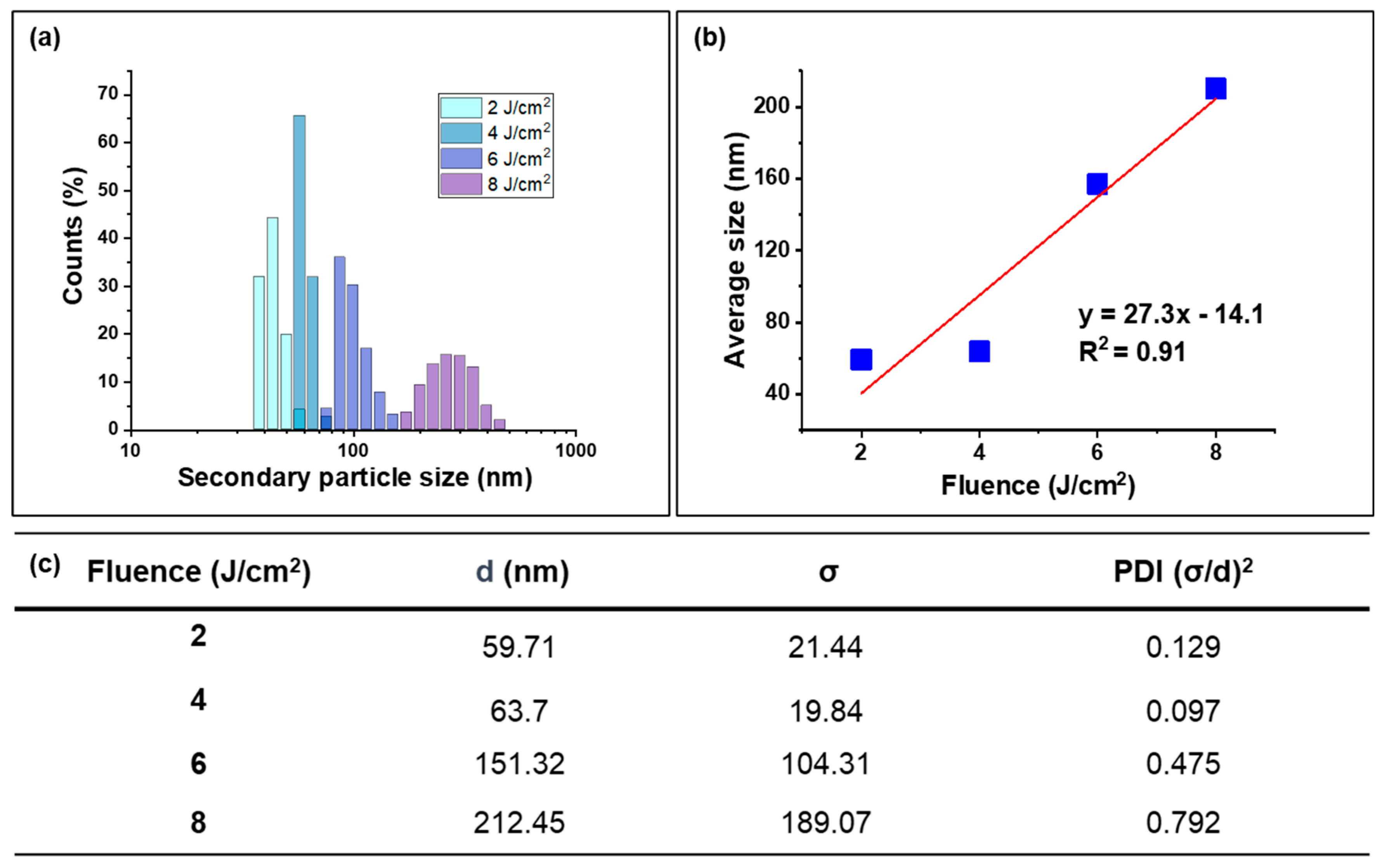
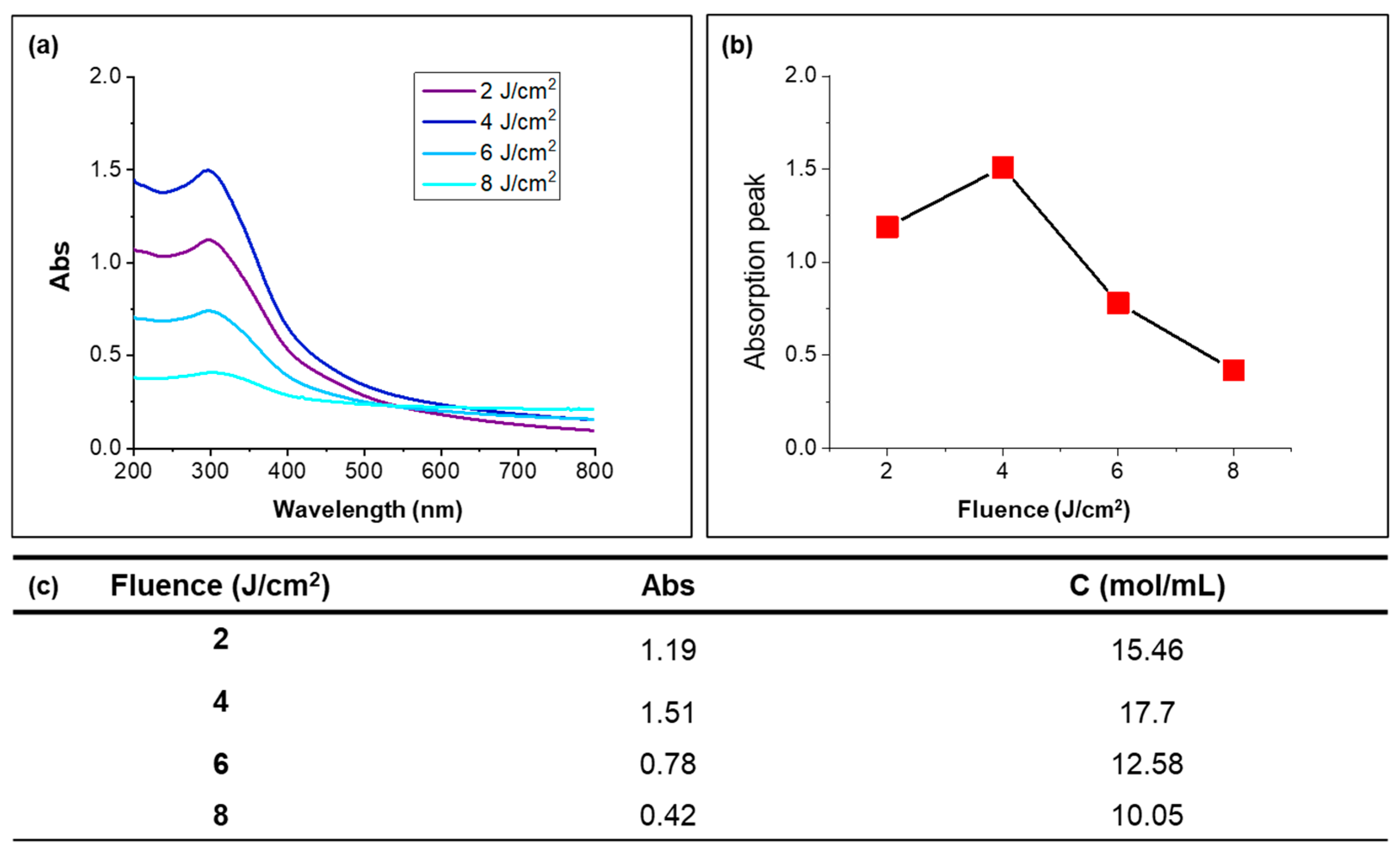
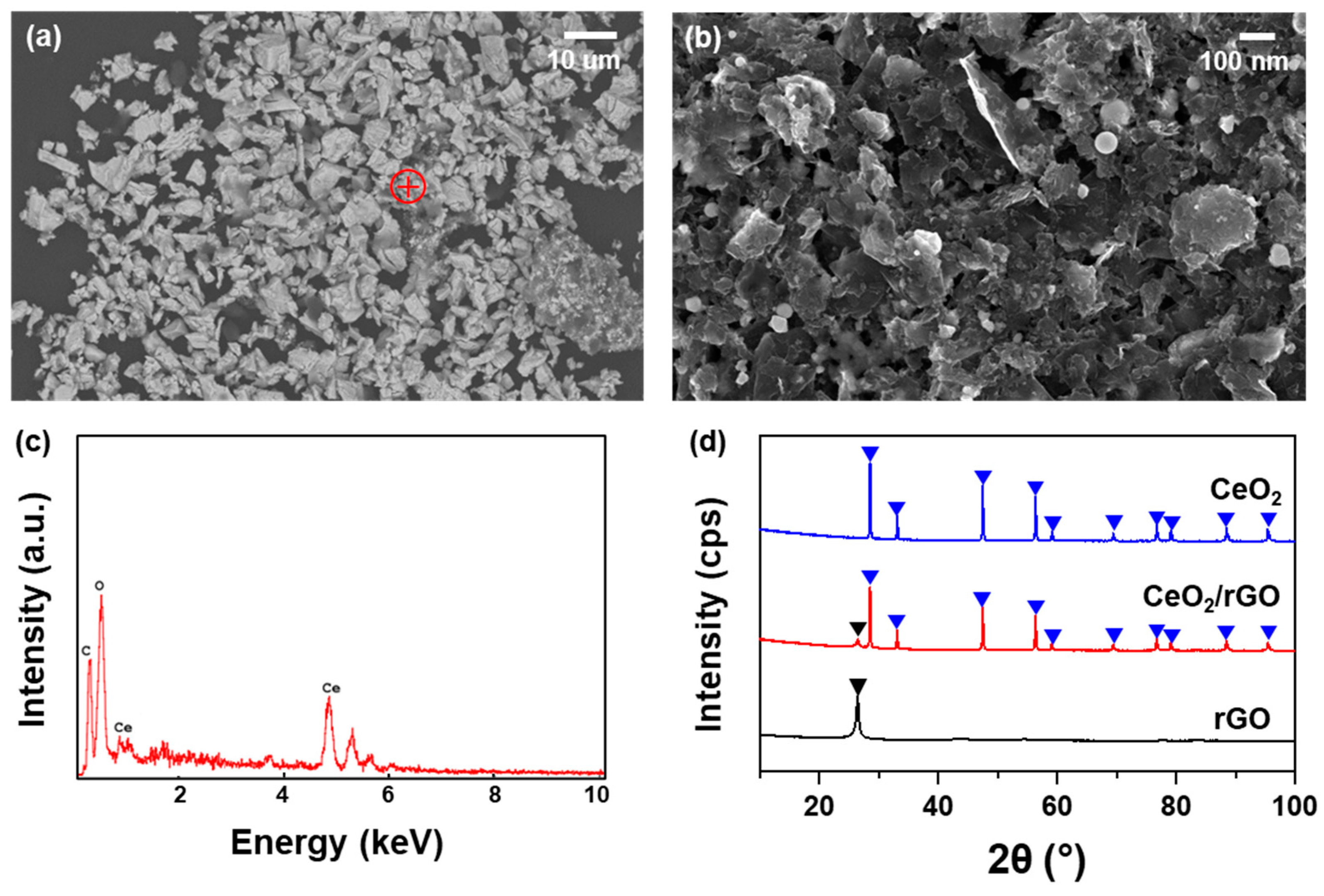

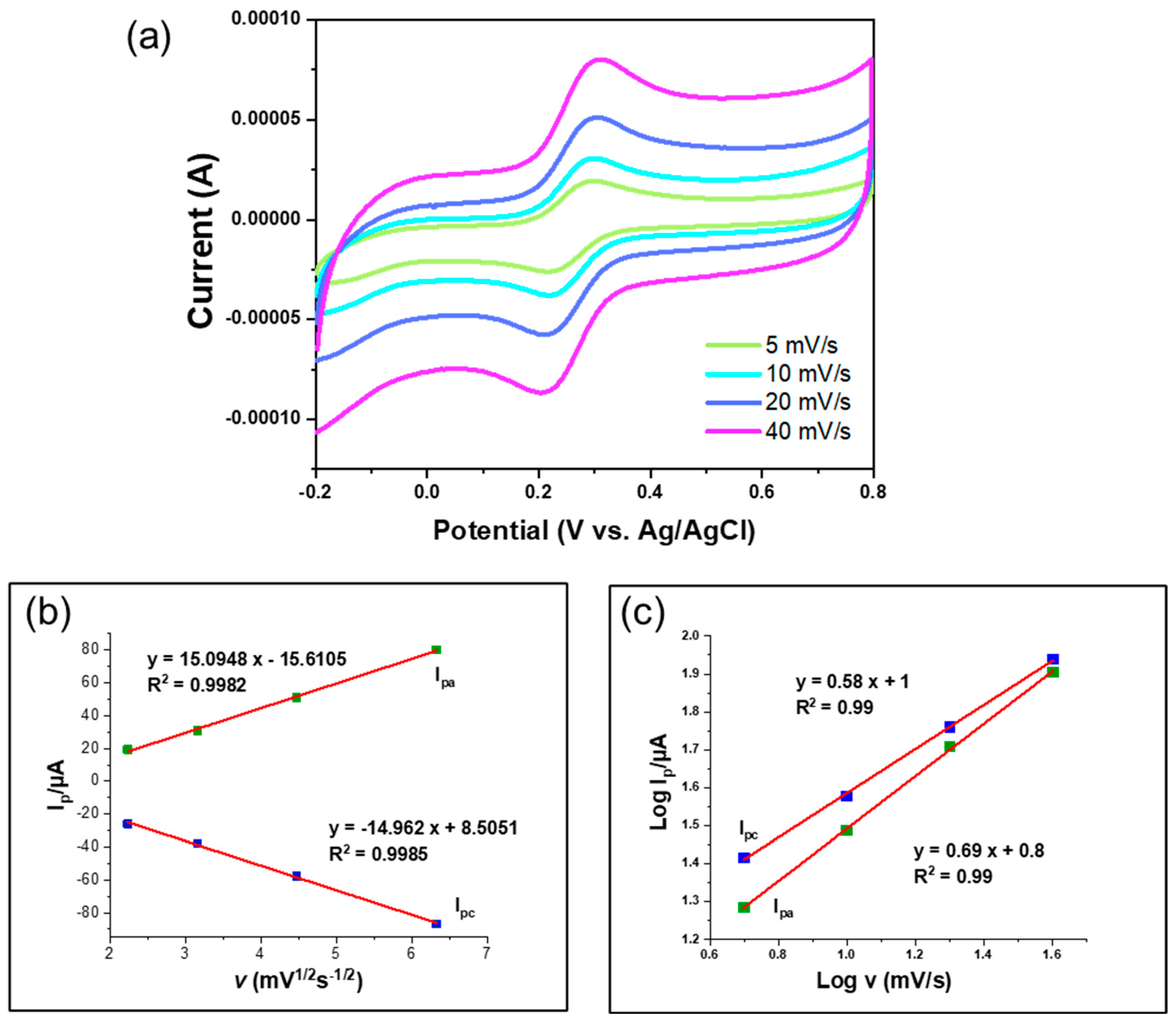
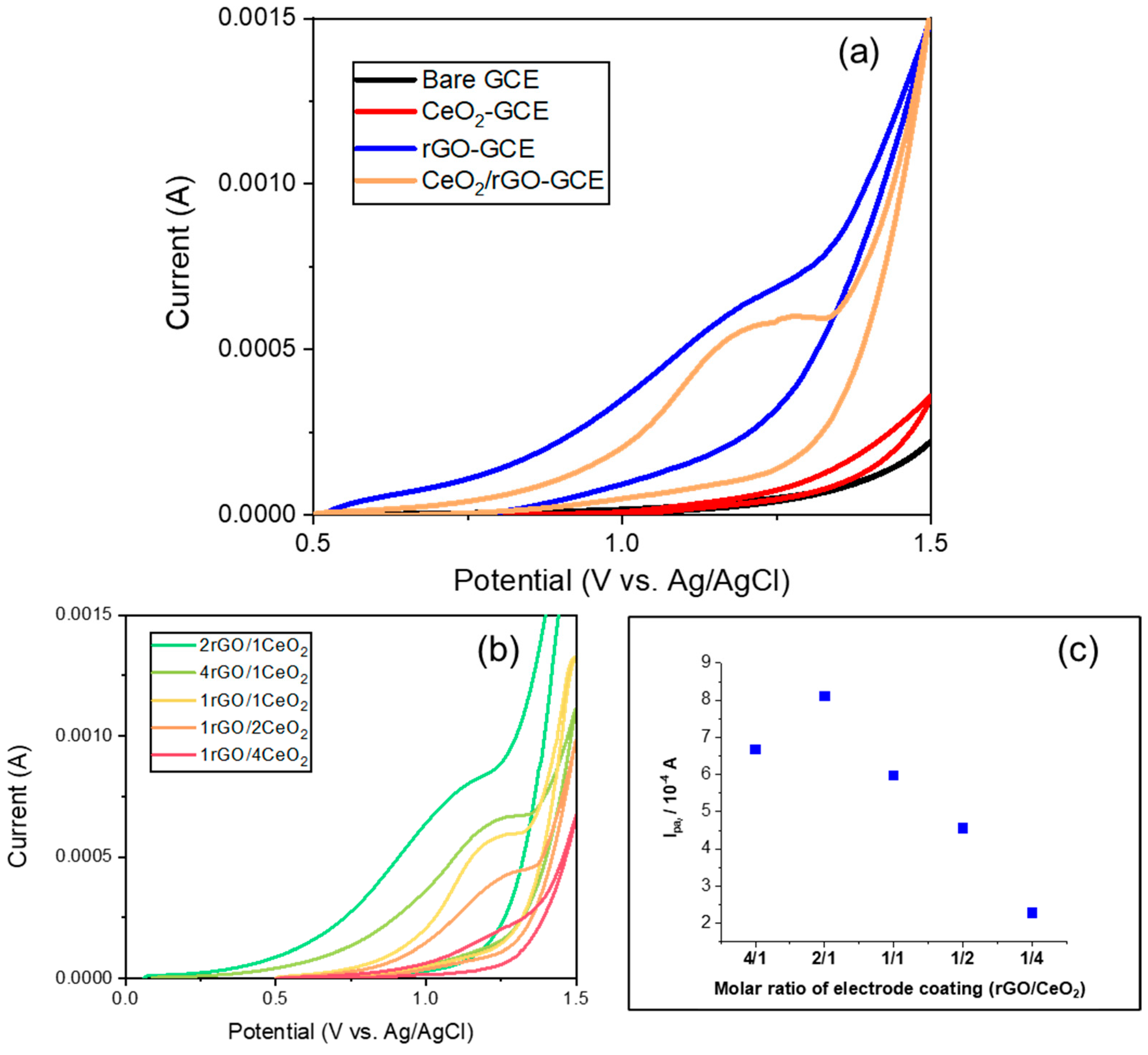
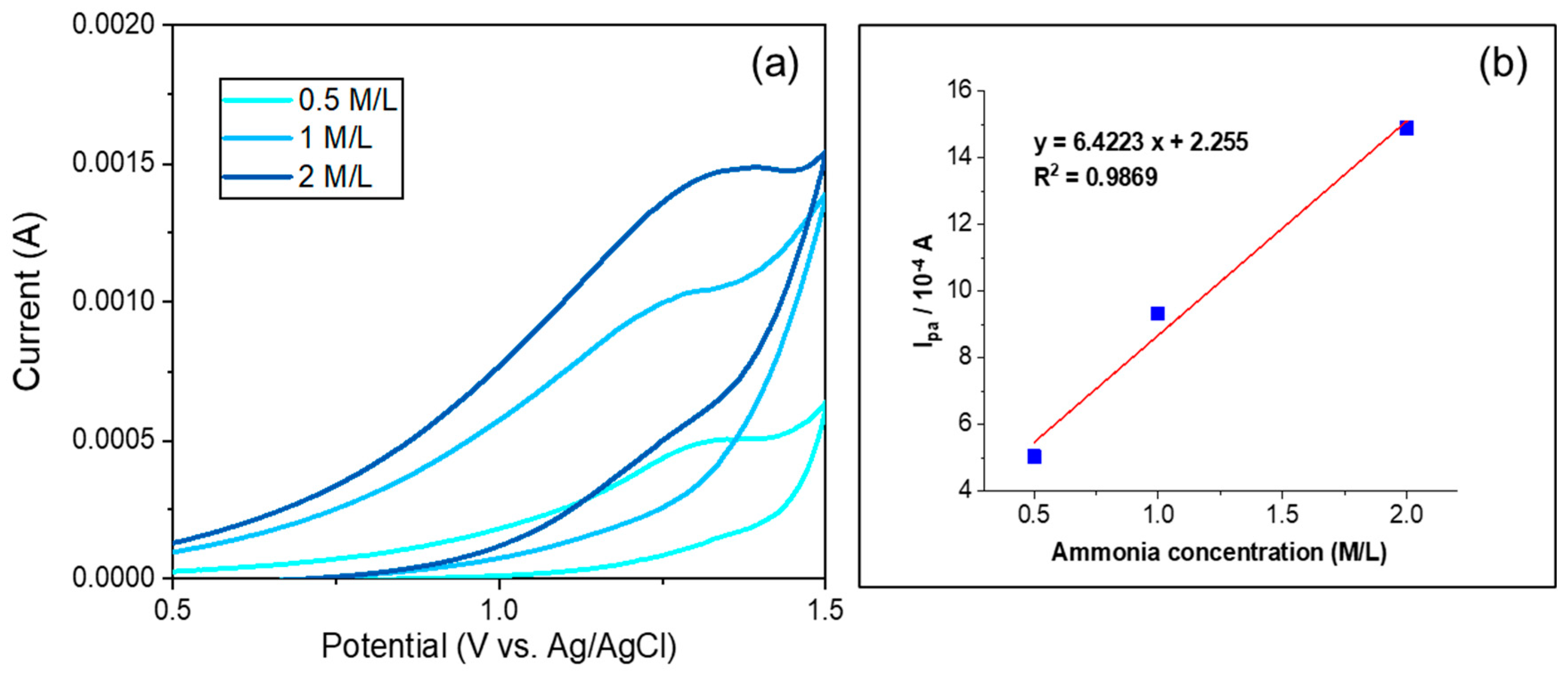
Disclaimer/Publisher’s Note: The statements, opinions and data contained in all publications are solely those of the individual author(s) and contributor(s) and not of MDPI and/or the editor(s). MDPI and/or the editor(s) disclaim responsibility for any injury to people or property resulting from any ideas, methods, instructions or products referred to in the content. |
© 2024 by the authors. Licensee MDPI, Basel, Switzerland. This article is an open access article distributed under the terms and conditions of the Creative Commons Attribution (CC BY) license (https://creativecommons.org/licenses/by/4.0/).
Share and Cite
Shi, M.; Wada, H. Optimized Ammonia-Sensing Electrode with CeO2/rGO Nano-Composite Coating Synthesized by Focused Laser Ablation in Liquid. Nanomaterials 2024, 14, 1238. https://doi.org/10.3390/nano14151238
Shi M, Wada H. Optimized Ammonia-Sensing Electrode with CeO2/rGO Nano-Composite Coating Synthesized by Focused Laser Ablation in Liquid. Nanomaterials. 2024; 14(15):1238. https://doi.org/10.3390/nano14151238
Chicago/Turabian StyleShi, Mengqi, and Hiroyuki Wada. 2024. "Optimized Ammonia-Sensing Electrode with CeO2/rGO Nano-Composite Coating Synthesized by Focused Laser Ablation in Liquid" Nanomaterials 14, no. 15: 1238. https://doi.org/10.3390/nano14151238
APA StyleShi, M., & Wada, H. (2024). Optimized Ammonia-Sensing Electrode with CeO2/rGO Nano-Composite Coating Synthesized by Focused Laser Ablation in Liquid. Nanomaterials, 14(15), 1238. https://doi.org/10.3390/nano14151238





